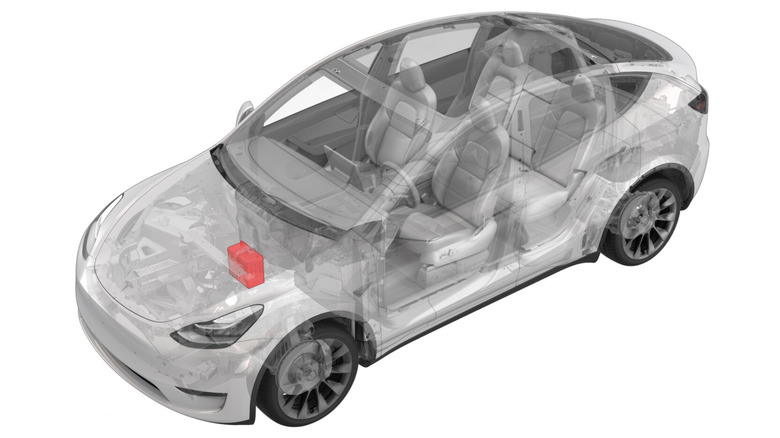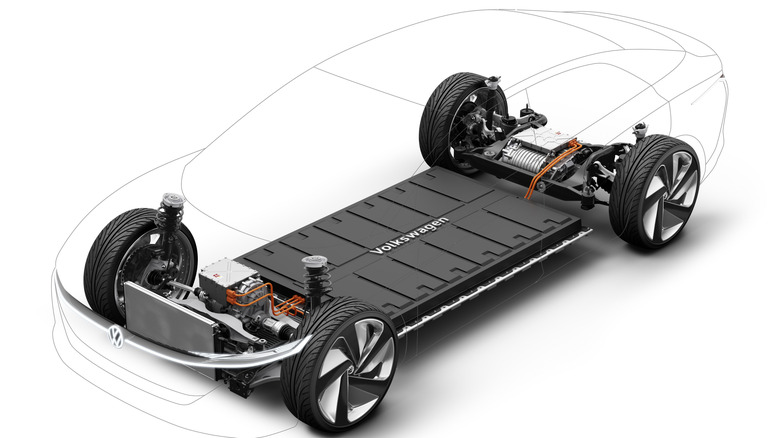Why Do EVs Still Need A Regular 12V Car Battery?
Electric vehicles are all the rage nowadays, and manufacturers are trying to one up each other every day as to who can fit the most efficient or the largest battery pack in an EV. But despite battery advancement moving forward so quickly, the 12V battery has remained more or less the same and EVs are still equipped with them despite having such a massive high capacity battery powering its motors. While EV manufacturers have tried to alter almost all aspects of a vehicle to be more suited to electrification, they have choses to stick with the 12V system still.
Now, there are many reasons as to why manufacturers still use 12V batteries in EVs. Most of it boils down to the safety and complexity of trying to supply such small currents efficiently. Some functions of the vehicle, like door locks and lights, need to work no matter what and the 12V battery is an easy solution which fulfills both purposes without causing much hassle and maintaining the ease of use even on new high-tech vehicles. An EVs battery is also one of the most expensive component in the vehicle and there is some cost-effectiveness involved as well, but we have seen some pretty expensive EVs which still incorporate the 12V battery.
The use of 12V batteries in modern EVs
Let us first learn what these batteries are powering to understand the need for them better. Just like in regular ICE cars, the 12V battery in EVs power some of the most vital components of the vehicle. This includes the lights, horn, door locks, windows, power steering, infotainment system and any other low voltage items. This also includes the ECU (Electronic Control Unit) or the brains of the vehicle which powers all the aforementioned components as well as the driveline componentry of the vehicle.
Now, manufacturers like to use several types of batteries in an EV, but most of these batteries powering the 12V system of the vehicle are of the lead-acid type, which have been used in vehicles for several decades now. The batteries are cheap, easy to maintain and quite reliable, but some of the modern cars do use a lithium-ion battery for the 12V system as well, which allows for lighter weight and better performance.
The lithium-ion batteries also last quite a bit longer over the lead-acid batteries. Regardless of what battery is used to power the low voltage electronics in the vehicle, the 12V system has been something that everyone is familiar with, and it is easy to work around for the low voltage system even in EVs.
Why do EVs still have a 12V battery?
Replacing a 12V battery system in an EV is not only quite complex, but will in terms waste a lot of energy as well. Most EVs run on a high voltage architecture, which is used to power the electric motors of the vehicle. The high voltage batteries are usually rated at 400V or 800V. To produce components which work with this higher voltage would be an immensely painful task. The energy required to convert the higher voltage output to a lower voltage to run 12V systems in a car will cause greater inefficiencies as well, causing more wastage of energy than it would be to have a separate battery to power the low voltage electronics.
There is also the question of safety, which is what drives the development of any modern car. Having two batteries allows the manufacturers to separate the high voltage battery and the components from the low voltage ones. The passenger compartment is devoid of high voltage components, which proves to be a crucial element to consider when a car gets into an accident. The larger batteries are easier to disconnect in the event of a crash while the safety components like the lights, door locks, ADAS, airbags and ECU still get power. This is also a crucial point of consideration for first responders who do not need to deal with high voltage running through the vehicle.
Lastly, there is also the need for simplifying production of a vehicle. Most car component manufacturers already are building 12V systems for other cars and these are easier to integrate these existing systems into even new high-tech EVs, making manufacturing quick and easy and most importantly, cheap for manufacturers.


